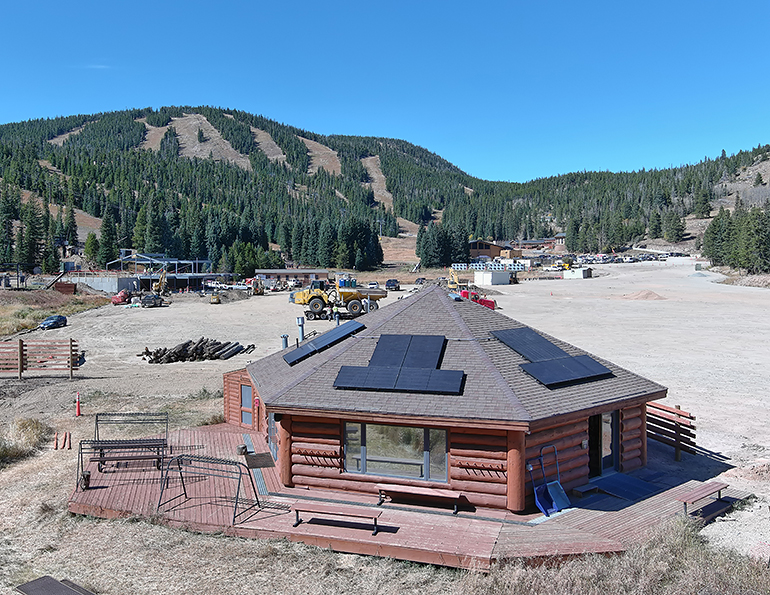Ski areas everywhere are being slammed with rising energy costs, and there seems to be no end in sight. But operators are finding solutions to reduce energy consumption, pinpointing obvious—as well as obscure—methods to counter costs.
Plan, Utilize Resources
“Overall, the biggest thing I’ve learned is once you have numbers and a plan, you can start tackling these problems and reducing consumption,” said Katherine Seleski, general manager at the nonprofit Pass Powderkeg in Alberta. “Our snowmaking master plan identified how badly we need VFDs on our pumps, and an energy audit showed that while I thought our base lodge roof was losing lots of heat, our windows were worse. It’s all about knowledge and ticking off the list while you can.”
Planning ahead to understand where an investment in time and money will have the greatest impact is vital, and there are a variety of resources out there to help—some of which exist for that purpose.
Sunday River, Maine, general manager Brian Heon stressed the importance of developing relationships with entities that can provide help, such as your utility provider and programs like Efficiency Maine, a quasi-state agency established to plan and implement energy efficiency programs for Maine homes and businesses, including rebates, discounts, and other support.
“There’s a ton of value in working with efficiency programs, whether they be on the public or private side,” said Heon. “Most are on the public side, like Efficiency Maine. Work with those people, get to know them, invite them to your resort, show them around. Their job is to provide funding for things that reduce your business’s energy consumption. Make it easy for them to give you money.”
Sunday River has received funds from Efficiency Maine to replace every light bulb in its buildings with LED bulbs, install EV charging stations, and more.
Heon said Sunday River’s electricity provider also offers incentives to reduce energy consumption and utilize renewables. “The only way I’ve learned about these is by sitting down with the person who handles our account,” he noted.
Eldora, Colo., recently completed two energy audits and will conduct a third this season, according to Hunter Wright, director of sustainability and project development.
 Eldora, Colo., added a solar array to the roof of its Nordic Center this summer.
Eldora, Colo., added a solar array to the roof of its Nordic Center this summer.
Among other things, “These surveys identified energy efficiency opportunities in our snowmaking operations,” Wright said. “The resulting energy management plan pinpointed specific areas for improvement, where we were able to prioritize upgrades and modifications to maximize energy savings, like investing in high-efficiency groomers and upgrading our main lift to significantly reduce energy consumption.”
Getting Strategic
Cold temperatures are not all Laszlo Vajtay, president and GM at Plattekill Mountain, N.Y., waits to see before turning on his snow guns.
He also waits until after the monthly meter read.
“For us, it is absolutely imperative to manage our energy costs, so much so that we are very, very cautious with demand,” Vajtay said. “Demand costs are one of the biggest costs with respect to energy.”
To that end, Vajtay utilizes demand only after a meter read.
“I’m willing to pay that demand charge for December, January, February, March,” he said. “But October and November may have only a few snowmaking days. I can’t generate enough ticket sales to justify that expense. Corporate areas write it off to marketing. We wait until there is a long stretch of snowmaking weather, but it has to happen after the meter read, and then we budget for demand.”
In addition, Plattekill added variable frequency drives (VFD) to its snowmaking air compressors and its two chairlifts and two conveyor lifts, which has made a big difference. “Leaving energy on the grid is a big deal for small areas like us,” he said.
A Look at Snowmaking
Snowmaking, of course, consumes a tremendous amount of energy. Investments in new, more efficient snow guns have been widely adopted at ski areas across North America. In addition to installing VFDs, Plattekill further improved snowmaking efficiency by replacing 90 percent of its snow guns with low-e guns. “We realized payback, measurable savings, in the first year of operation,” said Vajtay.
“We [Vermont ski areas] have been working on snowmaking for 23 years and have what I deem one of the most efficient snowmaking systems anywhere in the country,” said Chuck Clerici, ski team leader at Efficiency Vermont, a ratepayer-funded service that provides energy solutions for Vermont consumers and businesses, similar to Efficiency Maine.
Clerici said Vermont ski resorts have invested heavily in low-energy snow guns with the help of Efficiency Vermont, which has subsidized big portions of the investments in exchange for resorts retiring their old, inefficient equipment—a move that has dramatically reduced energy consumption.
“The older generation of guns used 300 to 500 CFM of compressed air,” said Clerici. “We’ve replaced them with guns using 60 to 120 CFM. It’s been a massive reduction.”
Another method of reducing energy use in snowmaking operations is to reduce the amount of snow that needs to be made. At Pass Powderkeg, that meant teaming with an earthworks company to identify “a list of our biggest headaches from a terrain perspective,” said Seleski—i.e., areas where a ton of snow needed to be made to safely open—and figure out the cost to rectify the issues. The earthworks company then reworked the terrain, flattened the slope, filled in holes, and addressed odd angles.
Seleski calculated the project would result in saving 128 hours of snowmaking and more than $10,000 in costs annually. “It also allowed us to reduce the snowmaking need enough that we could open a week earlier in the first year alone, which is a huge help for revenue,” she said.
The ski area also cuts the vegetation on snowmaking trails low to the ground because “every inch closer to the ground your vegetation is, it’s one more inch of snow you don’t have to worry about,” said Seleski.
Facility Improvements
With so much progress on the hill, resorts are increasingly turning their attention to de-carbonizing their facilities and making them more efficient.
This past summer, Eldora added a solar array to its Nordic Center, said Wright, and is incorporating energy-efficient design principles into its new lower mountain lodge (planned for completion in October 2024). These include insulation, energy-efficient windows, and solar.
Heon recommended using electric heat pumps, which are highly efficient in the right conditions, and are ideal for remote structures like the top shacks of lifts and booster pump stations that have electricity but are difficult to deliver propane or other fuels to.
Of course, retaining heat inside buildings will save money and resources, but older buildings at ski areas in Vermont, and elsewhere, tend to lack proper insulation. “A lot of the buildings are 50 to 60 years old,” said Clerici. “They’re not well-insulated, they’re losing heat—they need a new jacket on them. That’s a big investment for the mountains. They’re working on it, but there’s a lot to do.”
Vermont’s Jay Peak is implementing flexible load management (FLM), which will lower the resort’s energy use during peak times. “If there’s a big space we need to heat or cool with electricity in the afternoon, for example, when rates are higher, we’ll try to pre-heat the space a couple of hours earlier so during peak times it’s not on,” said director of facilities and resort services Andy Stenger. Jay Peak will use FLM in hotel corridors and common areas as well.
Alternative heating systems are also a good option. Plattekill, for example, replaced the oil boiler for its base lodge with an outdoor wood burner. “Since then, we have not burned an ounce of oil,” Vajtay said. “It was a very cool upgrade.”
Also cool is the geo-thermal system that Snow Trails, Ohio, installed several years ago, which uses ground water for heating and cooling in a continuous loop system.
“We essentially got rid of propane,” said GM Scott Crislip. “Ninety-nine percent of our energy comes from electric. The only propane we use is in our kitchens and backup generators.”
Clerici said Efficiency Vermont has started a new initiative this past fall to educate Vermont ski area operators on the benefits of ground source heat pumps. “But it tends to be the most expensive upgrade upfront,” Clerici added.
Less-Expensive Initiatives
Other energy saving initiatives are less expensive—even free, in the case of common sense.
“We try to run the resort like a household,” Crislip said. “Be conservative, don’t heat rooms we’re not using, turn lights off at night, negotiate our electric rates with our utility and then lock them in before the season starts, make snow at night when rates are down.”
And, as resorts work to find savings further and further down the energy consumption pole, LED lights and energy-efficient Energy Star appliances have essentially become standard.
“We worked with our utility, which paid half to replace every light bulb at the area with LED lights,” Vajtay said. “That has resulted in a huge savings.”
Other savings come from automated motion light detectors, powering down computers at night, consolidating refrigerators and coolers, and unplugging them when not in use.
“There is a concept of phantom load—things that draw energy even when not used,” Clerici said. “Walk-in coolers, refrigerators with nothing in them. Some of the mountains don’t need refrigerator equipment during the summer and will clean them out, unplug them, and leave the doors open. It saves some energy, not gigantic, but energy costs are real for everyone. Wasting energy, however small, is not in anyone’s bottom-line interest.”
Resort-Wide Buy-In
At Eldora, Wright said every department has energy-saving goals, and every employee is encouraged to buy into the resort’s sustainable vision.
“All of our departments have environmental goals for the season, whether it is purchasing Energy Star-rated equipment in food and beverage, working with our local utility to complete a refrigerator efficiency audit in base operations, upgrading to high-efficiency laptops for year-round staff, defaulting printers to double-sided printing in IT, increasing insulation in our lift shacks, purchasing high-efficiency heaters, and ensuring doors and windows remain closed. Every department is responsible for increasing efficiency,” she said.
“What’s so neat about the energy field—if you set aside the environmental side—it has a very real bottom-line impact,” Clerici said. “Add in the environmental impact, and there are just so many wins.”






